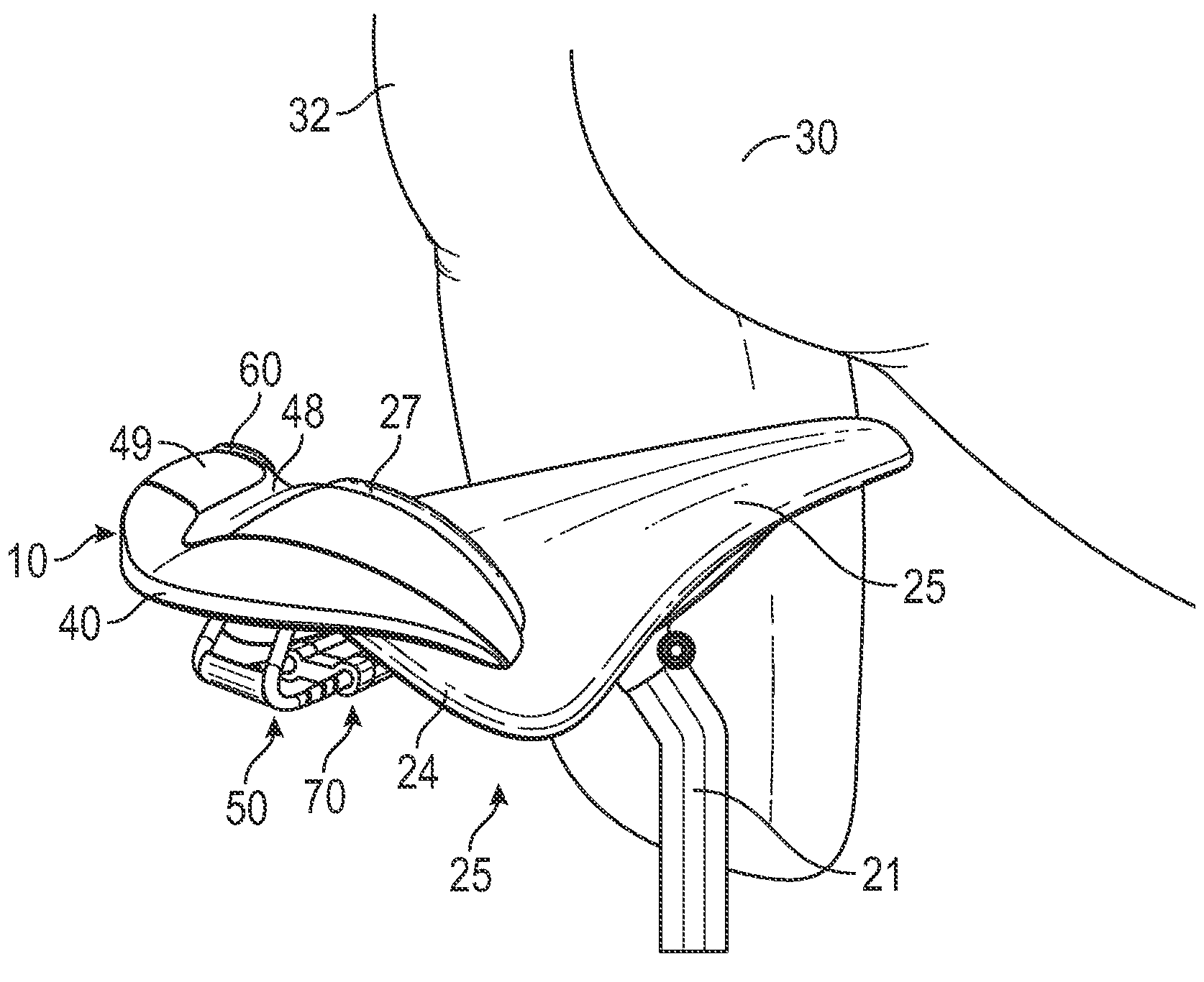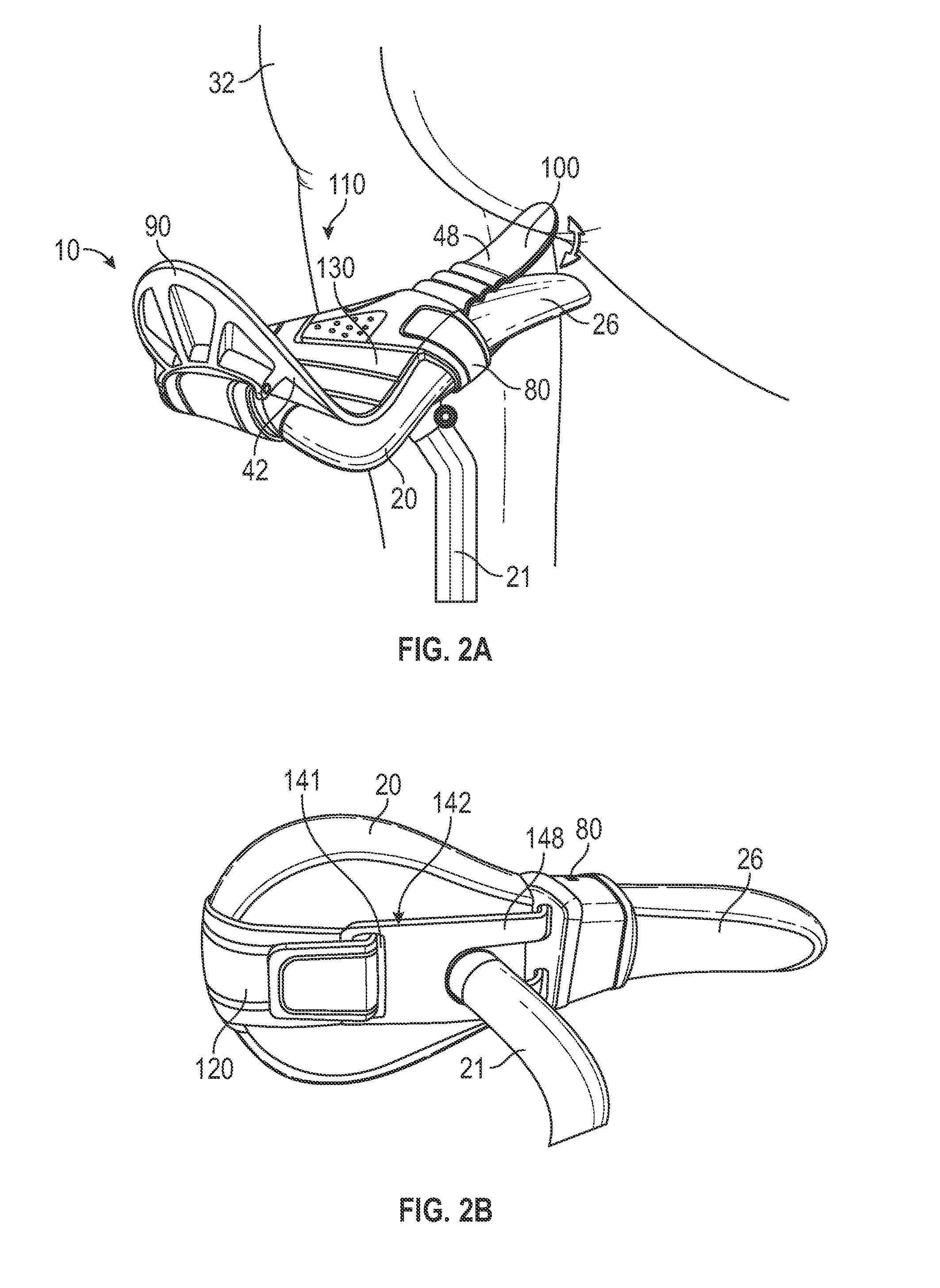Stabilizing bicycle seat
a bicycle seat and stabilizer technology, applied in the field of bicycle seats, can solve the problems of cycling often shifting lateral positions on the seat undesired, no solutions exist to reduce energy waste, etc., and achieve the effects of stable body-to-seat interface, simple installation, and increased power
- Summary
- Abstract
- Description
- Claims
- Application Information
AI Technical Summary
Benefits of technology
Problems solved by technology
Method used
Image
Examples
second embodiment
[0039]FIGS. 2A and 2B illustrate a second embodiment wherein the bicycle seat attachment 10 includes the base 40, a forward end 48, a rearward end 42, and a downwardly-projecting rigid loop 80 adapted to receive therein a forward thin portion 26 of the bicycle seat 20. The rearward end 42 terminates in an upwardly-raised flange 90 adapted to buttress the posterior 32 of the person 30. The forward end 42 terminates in a resilient upwardly-projecting tongue 100. The base 40 thereby forms a saddle 110 for inhibiting forward and rearward motion in the seat 20 by the person 30. Preferably the upwardly-projecting tongue 100 is malleable and, as such, selectively angularly adjustable. Further, preferably the upper side 49 of the base 40 includes a plurality of laterally traversing ridges 130 for inhibiting through friction backward and forward movement of the person 30 while seated thereon.
[0040]In such an embodiment, the clamping mechanism 50 is fixed to the rearward end 42 of the base 40...
seventh embodiment
[0048]In a seventh embodiment, illustrated in FIG. 7, the top side 118 of the bicycle seat 11 includes the longitudinal groove 160 and the lower garment includes a downwardly-projecting fin 270 from the posterior seat engagement portion 210. The fin 270 may be curved from front to back, whereby when engaged with the longitudinal groove 160 the person 30 may adjust his angular position from forward to rearward in the seat 11 while still being inhibited from lateral motion from side to side. As such, when the person 30 is seated on the seat 11 while wearing the lower garment 200, the fin 270 of the garment 200 engages the longitudinal groove 160 of the seat 20 to inhibit lateral motion of the person 30 while seated. In one embodiment, the fin 270 is selectively detachable from the lower garment 200, such as with a tongue-in-groove arrangement (not shown), or snap-in friction fit connection (not shown), or the like.
[0049]In such an embodiment, the top side 118 of the seat 11 may furthe...
eighth embodiment
[0050]In the invention, illustrated in FIG. 8, the posterior seat engagement portion 210 of the lower garment 200 includes a downwardly-projecting platform 280 adapted for engagement with the longitudinal groove 160 of the seat 11. A bottom side 162 of the longitudinal groove 160 may further include the plurality of laterally-traversing ridges 130, and the platform 280 of the lower garment 200 may further include the plurality of grooves 220 each adapted to receive one of the laterally traversing ridges 130 of the longitudinal groove 160. As such, when the person 30 is seated on the seat 11 while wearing the lower garment 200, the upwardly-extending ridges 130 of longitudinal groove 160 engage the grooves 220 of the platform 280 to inhibit forward and backward motion of the person 30 while seated. When the person 30 elevates his posterior 32 slightly off of the seat 11, he is free to adjust his position forward or backward with respect to the seat11 before sitting again on the seat ...
PUM
 Login to View More
Login to View More Abstract
Description
Claims
Application Information
 Login to View More
Login to View More - R&D
- Intellectual Property
- Life Sciences
- Materials
- Tech Scout
- Unparalleled Data Quality
- Higher Quality Content
- 60% Fewer Hallucinations
Browse by: Latest US Patents, China's latest patents, Technical Efficacy Thesaurus, Application Domain, Technology Topic, Popular Technical Reports.
© 2025 PatSnap. All rights reserved.Legal|Privacy policy|Modern Slavery Act Transparency Statement|Sitemap|About US| Contact US: help@patsnap.com



